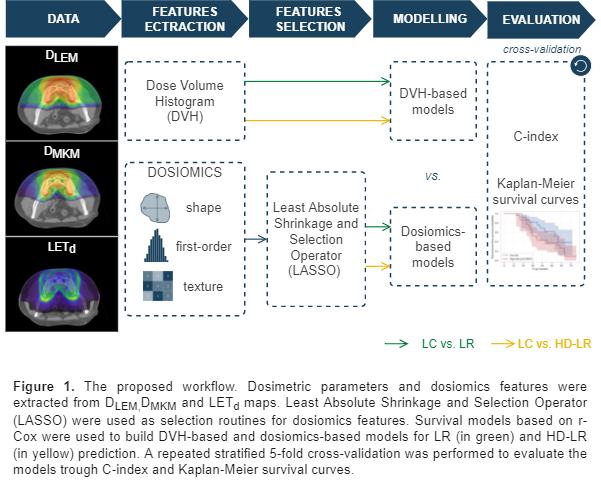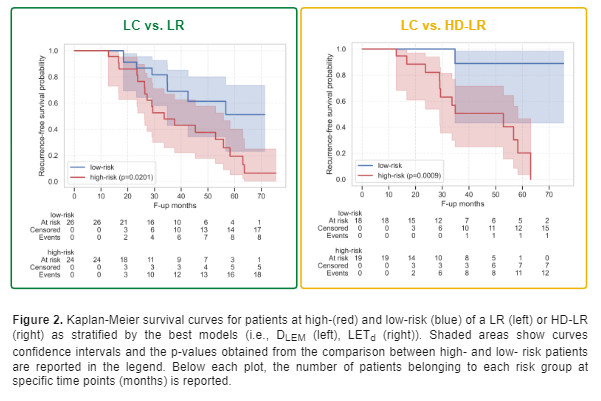Dosiomics applied to biological dose and LET maps to predict Local Recurrence in Sacral Chordoma
PO-2094
Abstract
Dosiomics applied to biological dose and LET maps to predict Local Recurrence in Sacral Chordoma
Authors: Giovanni Parrella1, Letizia Morelli1, Simone Annunziata1, Silvia Molinelli2, Giuseppe Magro2, Mario Ciocca2, Agnieszka Chalaszczyk3, Maria Rosaria Fiore3, Chiara Paganelli1, Ester Orlandi3, Guido Baroni1
1Politecnico di Milano, Department of Electronics, Information and Bioengineering, Milano, Italy; 2National Center for Oncological Hadrontherapy, CNAO, Medical Physics unit, Pavia, Italy; 3National Center for Oncological Hadrontherapy, CNAO, Clinical Unit, Pavia, Italy
Show Affiliations
Hide Affiliations
Purpose or Objective
Sacral chordoma (SC) is a rare, locally invasive, and aggressive malignant tumour characterized by high radioresistance and probability of recurrence. Carbon Ion Radiotherapy (CIRT) is one of the most promising therapeutic options to reduce Local Recurrence (LR) in SC. However, the poor tumor characterization and the lack of prognostic biomarkers do not allow improving the efficacy and the personalization of SC treatments.
The aim of this study is to apply, for the first time, a dosiomics approach to biological dose and dose-averaged Linear Energy Transfer (LETd) maps, towards the identification of possible prognostic factors for CIRT treatment outcome prediction.
Material and Methods
50 SC patients treated with CIRT at the National Centre for Oncological Hadrontherapy (Italy) were retrospectively selected together with treatment outcome information in terms of LR. After a median follow-up time of 42.6 moths, 24 patients were classified as recurrence-free (Local Control, LC) while in LR was found in 26 patients and, among these, 13 presented a recurrence in a high-dose region (High Dose Local Recurrence, HD-LR).
Dosiomics features and conventional DVH parameters were extracted from LETd maps and biological dose maps (DLEM, DMKM, Fig.1). Cox proportional hazard models regularized with an elastic-net penalty (r-Cox) were encapsulated in a repeated 5-fold cross-validation routine and patients were stratified in low/high risk of adverse treatment outcome in terms of both LR and HD-LR. Prediction performance of dosiomics- and DVH-based models were evaluated in terms of Harrell Concordance Index (C-index) and Kaplan-Meier (KM) survival curves were estimated and evaluated through log-rank tests (α=0.05).

Results
In LR prediction, the best performance was achieved with DLEM dosiomics features, reaching a C-index (median(interquartile-range)) of 0.70(0.18) and statistically significant KM curves (p-value=0.0201, Fig.2). In particular, patients at high-risk of LR were characterized by the presence of periodic patterns within the dose map.
In HD-LR prediction, the model with highest performance was built on features extracted from LETd maps (0.86(0.22)), with DLEM and DMKM models showing promising but weaker results (0.83(0.21), 0.80(0.21)). Specifically, high-risk HD-LR patients were characterized by more heterogeneous LETd values and concentrated on lower values than low-risk patients. Similarly, in terms of KM curves, LETd-based models outperformed those of DLEM and DMKM, achieving highly significant low/high risk separations (p-values = 0.0009(Fig.2), 0.0075, 0.0072, respectively).
Finally, for both LR and HD-LR prediction, DVH-based models were found to be weakly predictive compared with dosiomics ones (max C-indices of 0.58 (LR) and 0.65 (HD-LR)).

Conclusion
LETd maps shows a great potential as prognostic factor for SC HD-LR in CIRT, and dosiomics appears to be the most promising approach against more conventional methods (e.g., DVH-based).